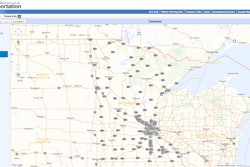
ADOT used the study results to settle on a 3- to 4-mile section of Interstate 17 near Phoenix as the prototype site using in-pavement sensors currently used to detect traffic moving in the right direction. Sensors also would be used at on-ramp locations.
These sensors would then send the vehicle’s location to the agency’s Traffic Operations Center and the Arizona Department of Public Safety, with the data also being placed on overhead message boards, as well as used to control on-ramp traffic signals to prevent traffic from entering in the vehicle’s path.
“While there are tremendous challenges in trying to prevent often-impaired drivers from entering a freeway in the wrong direction, we’re looking at a unique system to detect these vehicles quickly and warn Arizona state troopers, ADOT and other drivers,” says ADOT Director John Halikowski. “We believe this will be a first-of-its kind system featuring the use of our in-pavement traffic sensors to track wrong-way vehicles.”
The agency has already made strides in addressing wrong-way driving by installing more than 100 “Wrong Way” and” Do Not Enter” signs at on-ramps in the Phoenix area and at rural state highways. Arrows with red reflectors that glow only to wrong-way vehicles also were placed on several off ramps.
“Technology alone cannot prevent all wrong-way tragedies, but ADOT’s study and prototype for detecting and warning us about wrong-way drivers represent a positive next step,” says Alberto Gutier, director of the Arizona Governor’s Office of Highway Safety. “In addition to engineering, enforcement and education, there’s another ‘E’ to consider. It stands for everyone. We all need to work harder to keep friends, family and strangers from driving while impaired.”
Here are several key findings from ADOT’s wrong-way vehicle study:
- From 2004 through 2014, there were 245 wrong-way crashes with 91 fatalities in Arizona.
- About 65 percent of wrong-way drivers in Arizona crashes were documented as impaired during the study period, compared to 5.4 percent among all crashes.
- Twenty-five percent of Arizona’s wrong-way crashes were fatal, compared to less than 1 percent of all crashes.
- Fifty-three percent of wrong-way crashes were on urban divided highways and 47 percent occurred on rural divided highways.
- Interstate 17’s 39 miles in the Phoenix metro area had 26 wrong-way crashes during the study period and the most confirmed wrong-way crashes and fatal wrong-way crashes per mile in the state.
- Among rural areas, SR 89A in the Verde Valley had the highest rate of wrong-way crashes per mile, with three wrong-way crashes over 14 miles. Interstate 10 near Quartzsite had three fatal wrong-way collisions along a 16-mile stretch during the study period.
- Wrong-way crashes were more common after dark.
- Wrong-way crashes were more common on weekends.
- The majority of wrong-way drivers in Arizona were ages 16 to 35.
- Sixty-five percent of wrong-way drivers were male, 25 percent were female and 10 percent were documented as gender unknown.
- There was no significant difference between Arizona’s figures and national figures on wrong-way crashes.










